The oh-so-popular oscar! With its array of colors and patterns and a personality as big as it gets, it is no wonder that so many internet threads ask what Tank Size fish are compatible with Astronotus ocellatus.
A common concern in these threads is the oscar’s tendency toward aggression.
With such fish, the key is to start with a large tank to reduce stress and territorial behavior.

Oscars grow to an adult size of 10 to 12 inches and are best housed in a minimum tank size of 75 gallons for a single fish.
Include plenty of hiding places, which provide a safe place to retreat and temper aggression.
Consider the following when looking into the compatibility of fish you intend to pair with your oscar:
- Water parameter requirements
- Dietary needs and feeding habits
- Adult size – select fish that are around the same size as your oscar
- Temperament – do they have similar temperaments, or are they passive fish that keep to themselves?
- Level of the water column occupied – some fish that occupy the same levels will work while others will have a conflict.
- Are they schooling fish? Will you need a bigger tank?
Avoid the following:
- Fish that are extra sensitive to fluctuations in water conditions. Oscars are messy and produce a fair amount of waste, which can contribute to high nitrates in the water. Keeping your water clean is important to the health of all fish in your aquarium.
- Small, slow-moving fish – these are simply too tempting of a target for your oscar.
- Fish that require a peaceful tank. For some fish, the oscar’s activity levels will stress them to an unhealthy level.
- Small invertebrates or shrimp – these are also tempting for your oscar.
Always add the tank mates first, then the oscar to reduce the chances of territorial aggression.
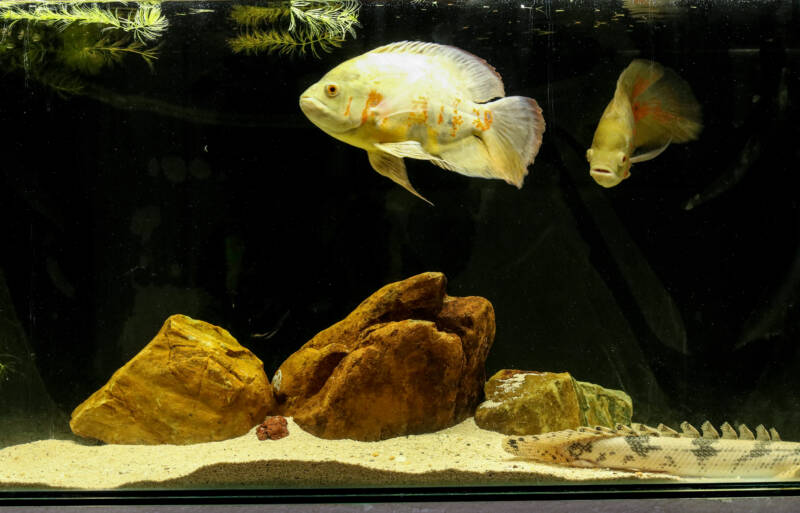
Remember, even if you do your research, provide the right environment, and follow all the recommendations, there is still the potential that individual personalities will not be compatible.
Observe the interactions between the fish and be prepared to separate them if need be.
The following are some of the many types that can pair with your oscar.
1. Another Oscar

Minimum Tank Size : 75 gallons
Pairing your oscar with another is by far the safest bet. You will not have to worry about differences in water conditions or nutritional needs.
Consider adding one additional oscar to start. Unless the two are a breeding pair, there is always the chance of territorial aggression.
Once dominance is established, you may find the weaker fish constantly being bullied. Monitor the interactions and adjust the situation as needed.
When adding additional oscars, remember that these fish produce a hefty amount of waste. Make sure your filter and cleaning schedule are adequate to keep the water clean.
2. Convict Cichlids (Amatitlania nigrofasciata)

Minimum Tank Size : 30 gallons
The ever-popular convict cichlid is a smaller fish from Central America. Reaching an adult length of only four to five inches, this feisty fish can nevertheless hold its own in an oscar tank.
Due to the convict’s smaller size, they are best kept with smaller oscars.
Convicts can be territorial and occupy the same water levels as do oscars, so plan on a good-sized tank with several hiding spaces to reduce aggression and allow the fish to establish territories.
Do not place a male and female convict in the same tank with your oscar. This will increase the chance of aggression due to breeding.
3. Clown Loach (Chromobotia macracanthus)

Minimum Tank Size: 150 gallons for a group of 5
The clown loach is a peaceful Indonesian species with beautiful black and orange stripes. It is a common resident in community tanks and pairs well with numerous other species.
Keep this fish in a school of at least five; otherwise, it will be shy and spend most of its time hiding.
To accommodate the school and their ultimate adult length of 12 inches, you will need an aquarium at least six feet long.
Because the oscar occupies the same water column levels as the clown loach, introduce these species with caution.
Make sure that the loaches are large enough that the oscar does not view them as prey.
4. Severums (Heros spp.)
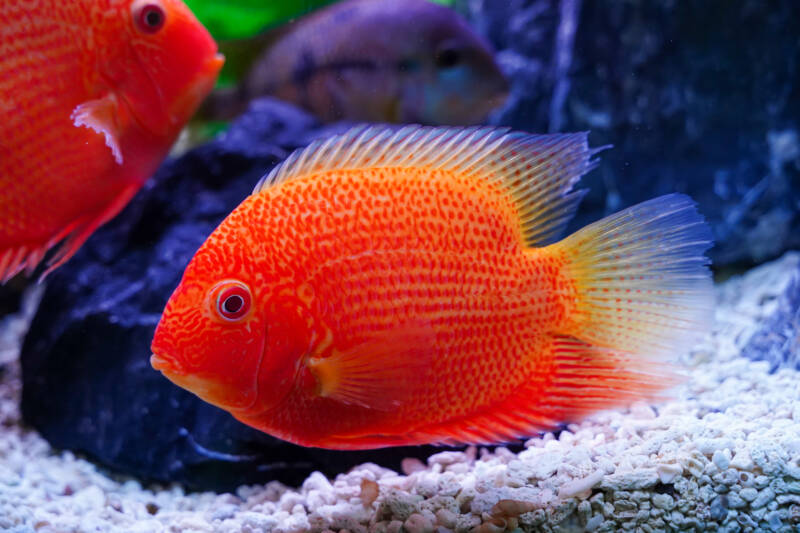
Minimum Tank Size : 75 gallons
There are several severum cichlid species hailing from South America and presenting a range of colors and patterns, including green, spotted, and banded.
They are less aggressive cichlids that reach up to 12 inches in length as adults.
Although they are peaceful in nature, they can readily defend themselves against any bullying from the more aggressive oscar.
They also pair well with other fish mentioned in this article, such as plecos and silver dollars.
When pairing severums with an oscar, select fish that are the same size and go with a larger tank.
5. Silver Dollars (Metynnis argenteus)
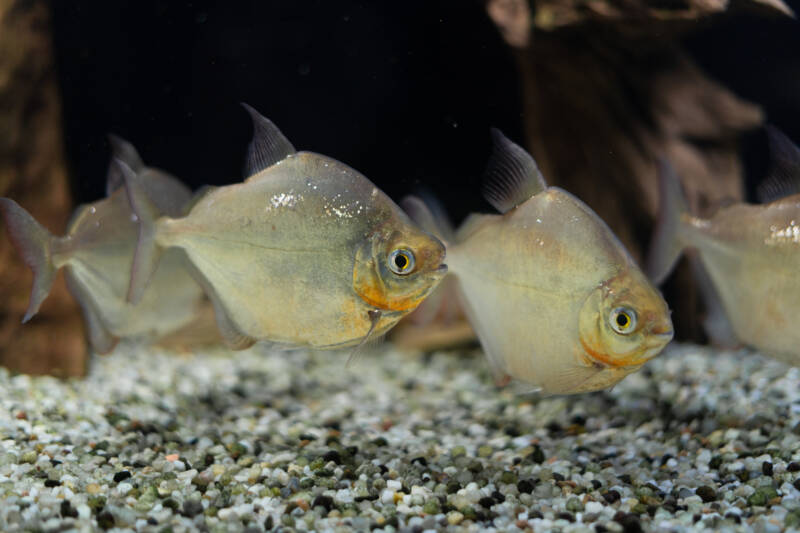
Minimum Tank Size : 75 gallons for a group of 5 fish
Silver dollars have several attributes that make them excellent partners for an oscar. First, their flat and disc-shaped bodies appear large and less appetizing to the oscar.
Second, they are schooling fish best kept in groups of at least five. Schooling behavior is beneficial to your oscar because it is a signal that there is no danger in the area.
This practice of adding “dither fish” is common in aquariums where aggression needs to be controlled.
Another benefit is that silver dollars eat mostly plants and will not compete with your oscar for food.
Finally, they are top-dwelling fish, which keeps them out of the water levels the oscar prefers.
6. Fire Eel (Mastacembelus erythrotaenia)
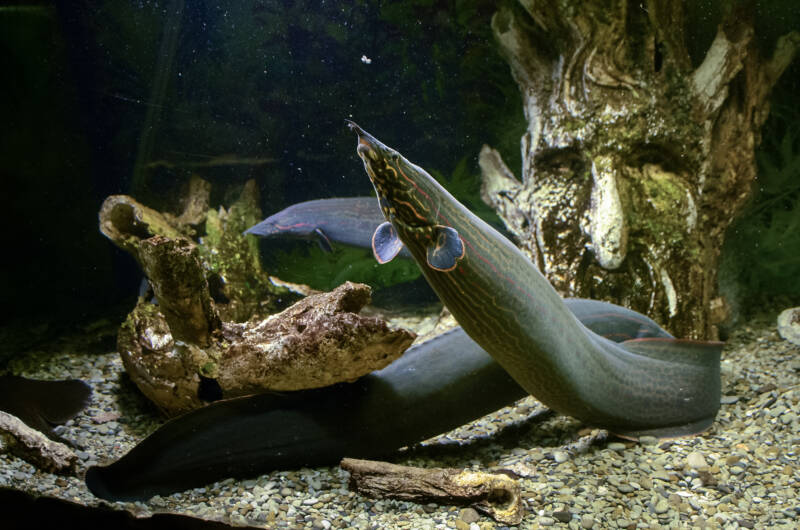
Minimum Tank Size : 80 gallons
This southeast Asian species is a freshwater fish with an eel-like appearance. Their sharp spines produce a mildly toxic slime, which should discourage your oscar from taking a bite.
A predatory bottom feeder, the fire eel grows up to 20 inches in length and needs a significant tank size.
Include a thick, sandy substrate in which your fish can dig, floating aquatic plants to dim the light, and large hiding spaces.
The overall size of the fire eel, combined with its protective spines and easy-going nature, makes it a good tank mate for your oscar.
7. Red Parrot (hybrid)
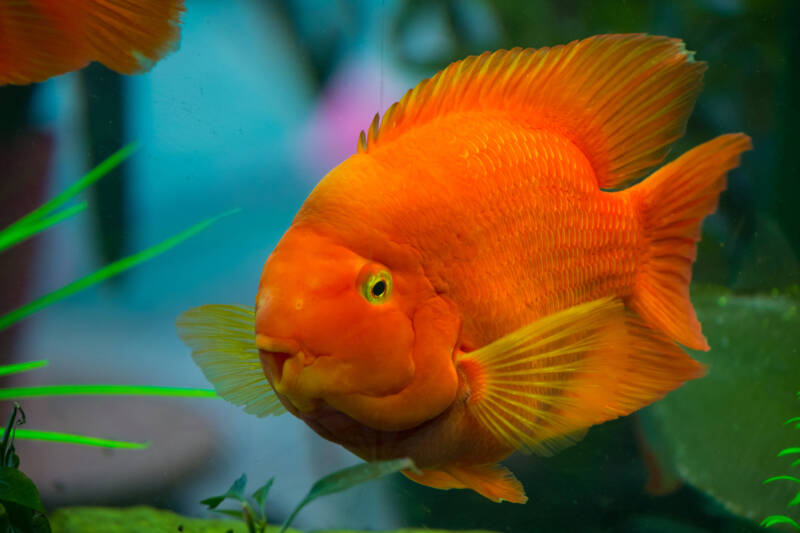
Minimum Tank Size : 30 gallons
The red parrot is a hybrid cichlid species. This beautiful, red-colored fish is curious and intelligent, reaching an adult length between six to eight inches.
They are not found in the wild, and their deformed mouths would make it difficult for them to survive outside of an aquarium.
Their teeth are set well back in the throat, so they cannot bite the way other cichlids can.
They are messy eaters; therefore, strict adherence to tank cleaning is necessary.
Once your red parrot is comfortable in the tank, it will get along just fine with your oscar, but keep an eye out for any aggression from the oscar.
8. Giant Gourami (Osphronemus goramy)
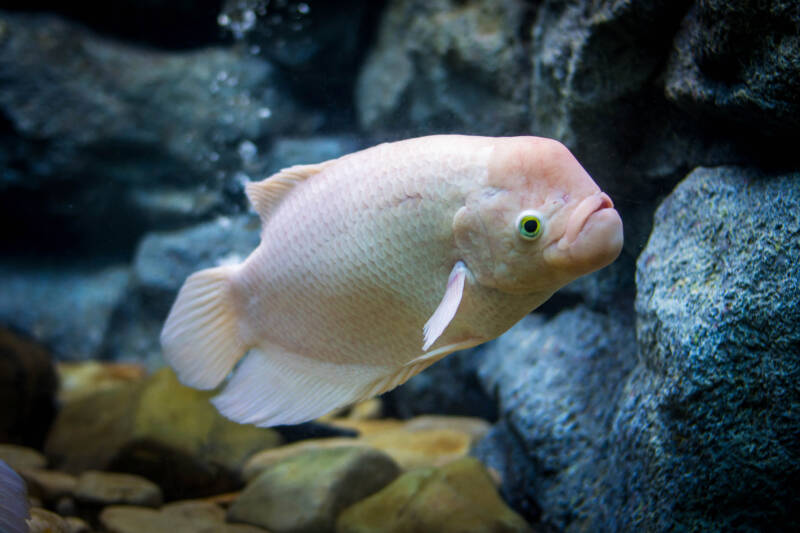
Minimum Tank Size : 200 gallons
The giant gourami is a fast-growing species from Asia. It is one of the largest fish you can pair with your oscar, reaching an adult size of 17 to 27 inches.
This fish is peaceful and suitable for a large species community tank.
They occupy the middle region of the tank but need occasional surface access to breathe using their labyrinth organ.
This species eats a predominantly vegetable-based diet, so it will not compete with your oscar for food. They produce a fair amount of waste and need good filtration with mild water flow.
9. Blue Acaras (Aequidens pulcher)
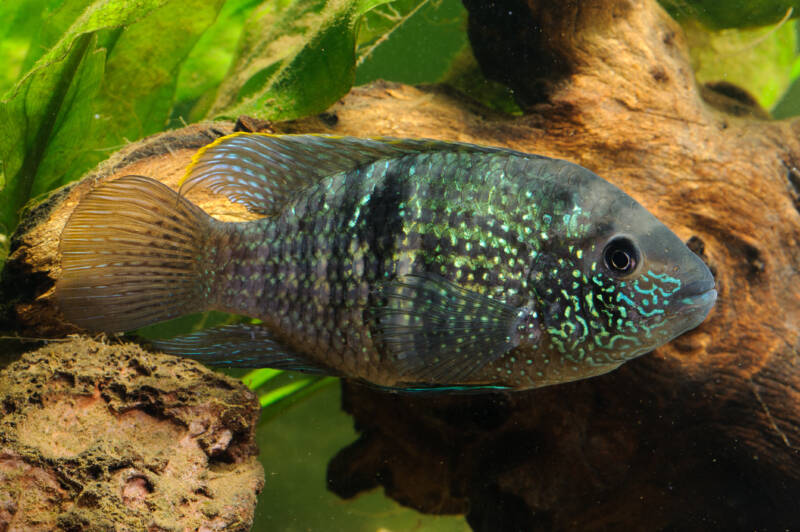
Minimum Tank Size: 30 gallons
The blue acara is not only stunningly beautiful; it is one of the more peaceful cichlid species you can find.
Coming from the warm waters of Central and South America, it reaches an adult length of six to seven inches and holds its own in a tank with an oscar.
It can be territorial and will push around smaller species.
When pairing the blue acara with an oscar, always go with a tank that is a little bigger than you think you need to accommodate the acara’s territorial behavior.
10. Bichir (Polypterus bichir)
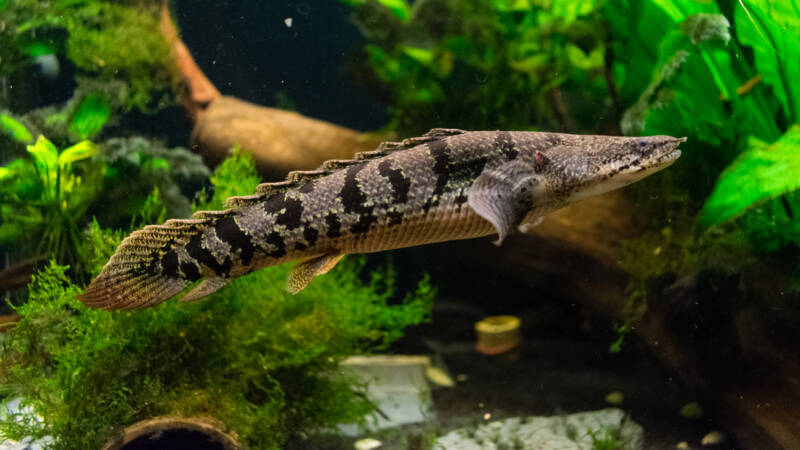
Minimum Tank Size : 90 gallons
If you are going for the “wow” factor in searching for your oscar’s tank mate, the bichir is your fish!
This eel-shaped native of Northeast Africa looks like it is straight out of a prehistoric movie. It sports a series of spiky dorsal fins; a large, fan-shaped tail; and oversized pectoral fins.
Depending on the type of bichir, they can reach anywhere between one to 2.5 feet in length.
Their size and bottom-dwelling habits necessitate a significant tank size. Choose a tank longer than it is tall to allow these fish access to the water surface to breathe.
11. Jack Dempsey (Rocio octofasciata)
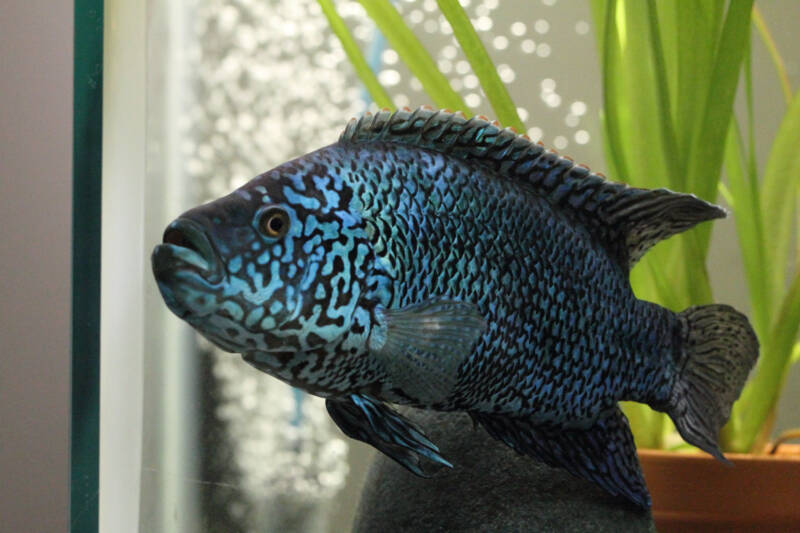
Minimum Tank Size : 55 gallons
This tough Central American cichlid comes in a range of colors that change due to age, stress, or breeding.
Jack Dempsey fish reach an adult size of six to eight inches and love the same water conditions as the oscar.
They need plenty of hiding spaces and room to establish a territory. When first introduced, keep an eye on interactions as each of these fish has a strong personality.
For reduced aggression, keep Jack Dempsey fish in a single sex group or a male with several females.
12. Green Terror Cichlid (Andinoacara rivulatus)
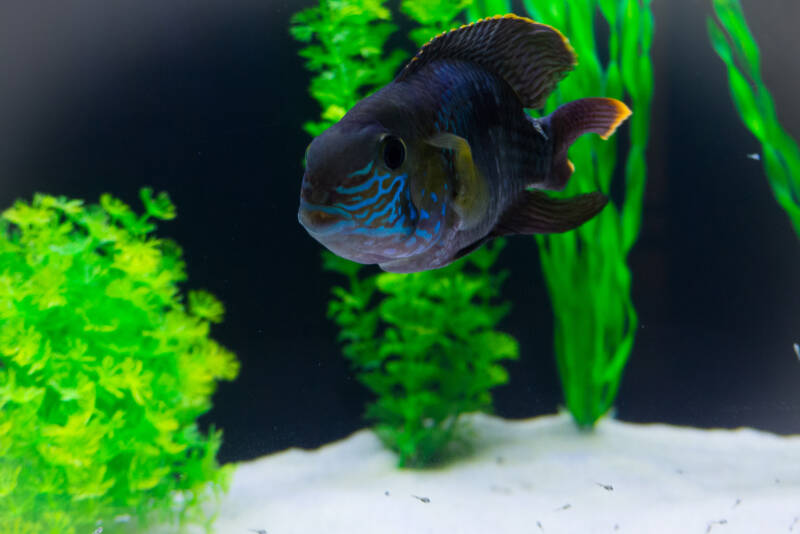
Minimum Tank Size : 50 gallons
The green terror cichlid is another great choice that hails from the western countries of South America.
It brings a bold personality and beautiful blue and green coloration to a home aquarium.
Because this species grows from 8 to 12 inches in length, it is best to keep your oscar with smaller green terrors. This fish is known for its aggressive nature.
If confrontation occurs, your oscar may come out on the losing side, so be ready to separate the fish. Aggression is more likely to happen in a tank that is too small.
13. Plecos (Loricariidae family)

Minimum Tank Size : 100 gallons
Plecos work well with oscars for several reasons.
Adult bristlenose and sailfin plecos grow anywhere from eight inches to just short of two feet in length, so your oscar is not likely to take a bite. Even if they do, plecos have sharp spines on their back that help protect them.
Finally, this fish is a peaceful bottom dweller that tends to keep out of the way.
One consideration with keeping a fish this large is the impact on the tank’s bioload. Regular maintenance and monitoring of water conditions are needed to keep this combination of fish healthy.
14. Silver Arowana (Osteoglossum bicirrhosum)

Minimum Tank Size : 250 gallons
The silver arowana is a highly aggressive freshwater fish from the Amazon River basin.
These fish are massive, up to three feet in length as adults. Therefore, you will need a tank at least eight feet long to allow them to develop properly and reduce aggressive behavior.
As with the oscar, the arowana is sensitive to nitrates and ammonia, needing effective filtration and regular water changes.
Keep the water softness toward the lower end of the oscar’s tolerance and the upper end of the silver arowana’s.
If conditions are stable, these fish should thrive together.
15. Firemouths (Thorichthys meeki)

Minimum Tank Size : 30 gallons
The firemouth is another Central American cichlid with a unique defensive behavior of inflating its gills and exposing a prominent red lower jaw.
This easy-to-care-for, smaller fish quickly grows to an adult length of five to six inches.
Firemouths are one of few non-aggressive cichlids that tend to avoid conflict rather than engage. As a result, plenty of hiding spaces in the tank are a must.
However, they can be aggressive when spawning, so keep that in mind if you have a breeding pair.
16. Pictus Catfish (Pimelodus pictus)
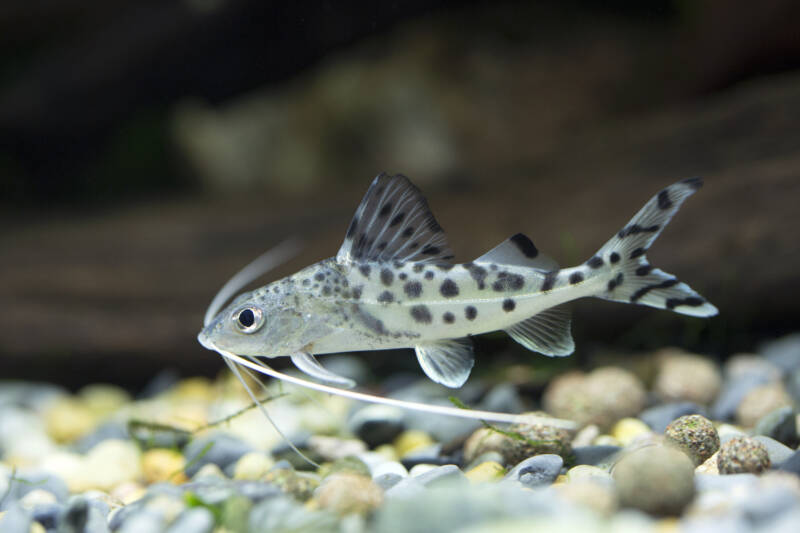
Minimum Tank Size : 55 gallons
The pictus catfish is a peaceful bottom-dweller from the Amazon. Bolder than other catfish species, they are often active during the day and emerge when food is offered.
Their adult size of four to five inches and sharp, serrated pectoral fins make the pictus less of a target for your oscar.
The pictus is slightly less compatible when it comes to water conditions. While the oscar prefers gentle waters, the pictus needs moderate currents.
Introduce this species with caution. Its compatibility with an oscar depends greatly on the individual personalities of the fish.
Closing Thoughts
As you can see, there are many choices when it comes to pairing your oscar in a community tank.
Remember that fish, much like people, have individual personalities. Therefore, you may have to adjust your plan and have a backup ready should the fish not get along.
Do your research, provide the right environment, and routinely monitor behaviors in the tank. Then, with some patience, you will find the right fish to pair with your oscar.
We would love to hear your success stories!
Which fish do you keep with your oscar?
